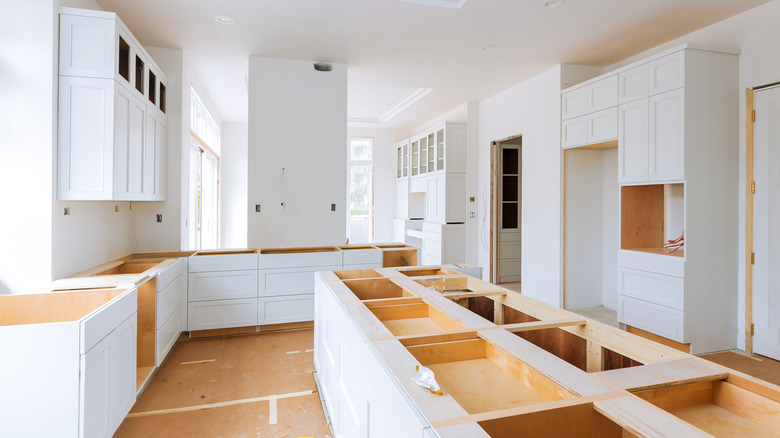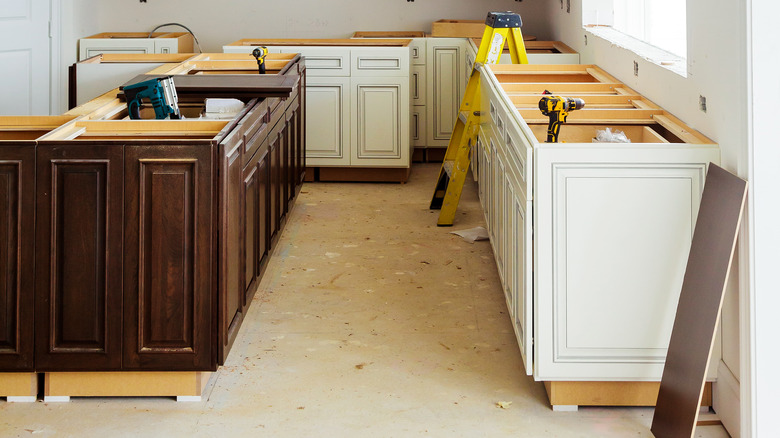One Thing To Remember If You're Installing Cabinets Before Flooring
Kitchen renovations are detailed endeavors, where one crucial oversight can quickly become a costly mistake. Cabinets can be the most expensive part of a kitchen remodel, so before taking on a DIY challenge, it is essential that you learn best practices and everything you need to know from experts about installing kitchen cabinets to avoid pricey errors. If you opt to install your cabinets before flooring, the one crucial thing to remember is to ensure your cabinets are high enough above the floor to fit the dishwasher and other under-counter appliances.
There is a correct order in which you should structure your home renovation project, though in the case of flooring and cabinets, you can choose to install them in either order depending on floor type. For hardwood and tile, installing the flooring before cabinets means that there are no cuts in flooring for cabinetry, which allows you to more easily make future changes to your layout, and there is no risk for fitting issues with under-cabinet appliances. For tile and floating floors, installing cabinets first requires buying less material and ensures that your floors remain protected from scratches and paint splatters throughout the project since the installation is at the end of the renovation. In the case of installing cabinets first, it is essential to plan for under-cabinet appliance clearances in addition to the new flooring thickness to be sure that they will fit.
Planning cabinet installation with flooring thickness in mind
The first step for planning your cabinet installation is research the thickness of the new flooring material itself and any required underlayment (speak with your installer if you are not sure what they plan to use) so you can calculate the overall height the new floor will extend above the subfloor. Once you have your measurement, use lumber to create wood spacers, or blocks, that are the same height as your new floor. Install them underneath your base cabinets to raise them up so that the bottom of the new cabinets will be at the same height as the top of the new floor. Insert your wood blocks back behind the face of the cabinet so that the flooring installers can slide the new floor right underneath for a seamless finish.
Similar considerations must be made if your installer plans to float your new floor — as they might if you're using vinyl plank flooring, for instance — over your existing floor without tearing it out. Your old floor should be treated as the subfloor in this case, taking into account the additional height of the floating floor and underlayment when installing cabinet blocks on top of your old floor. For remodels reusing existing cabinets, be sure to measure the additional floor height to see if you are able to use this floating installation method in and still fit your under-cabinet appliances.
The dishwasher doesn't fit ... now what?
What happens if you have already installed cabinets and flooring without properly planning for the new floor thickness (or mis-measured) and you are stuck in a dilemma where the dishwasher doesn't fit? Tearing out your new flooring could be extremely costly, endlessly frustrating, and set your remodel schedule way back. Perhaps the path of least resistance once the damage is done is not to rip anything out, but to instead invest in a new, shorter dishwasher that complies with the Americans with Disabilities Act (ADA).
ADA dishwashers are made to be about 2 inches shorter than standard appliances, with their overall height at about 32 to 32 ½ inches overall rather than 34 to 34 ½ inches high for standard dishwashers. This is because ADA-compliant countertops are dropped from the standard 36 inches high to a more accessible 34 inches high, so shorter appliances are required to fit under the lower countertops. All dishwashers have adjustable feet to raise and level them as needed by a couple inches to fit various openings, so these extra 2 inches of ADA clearance may be just the solution to save your remodel from a massive time and financial setback.


